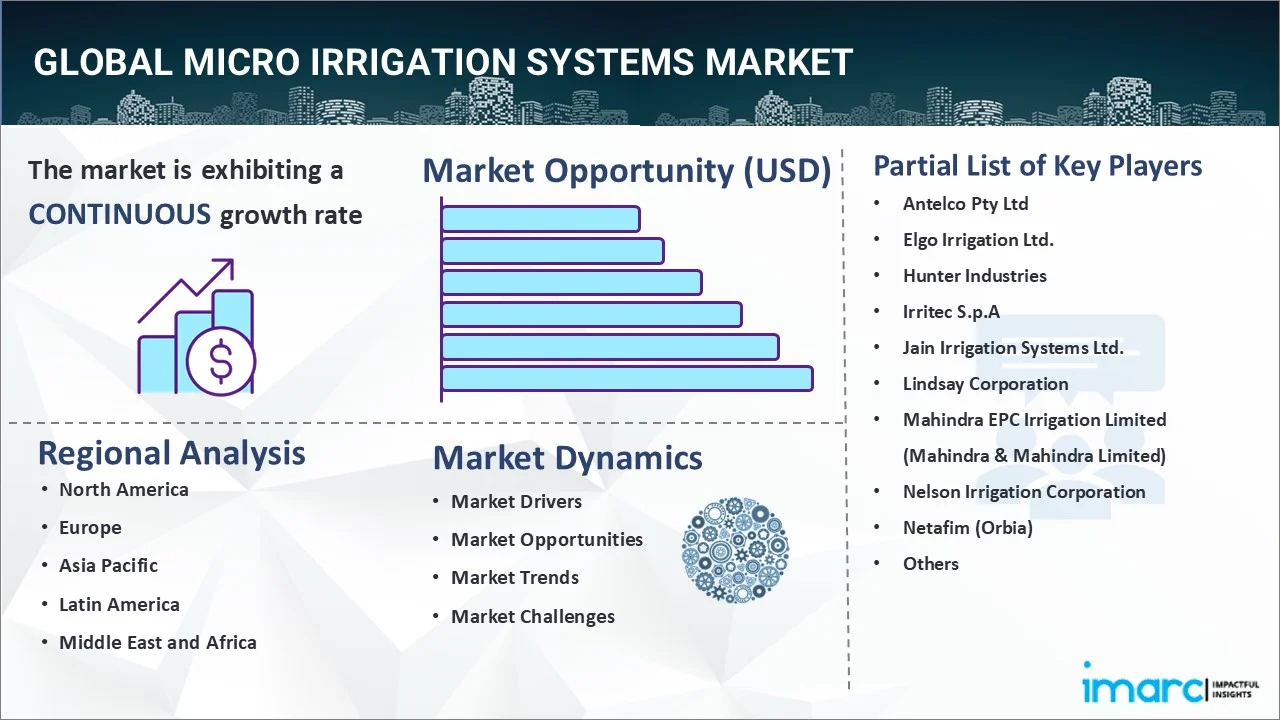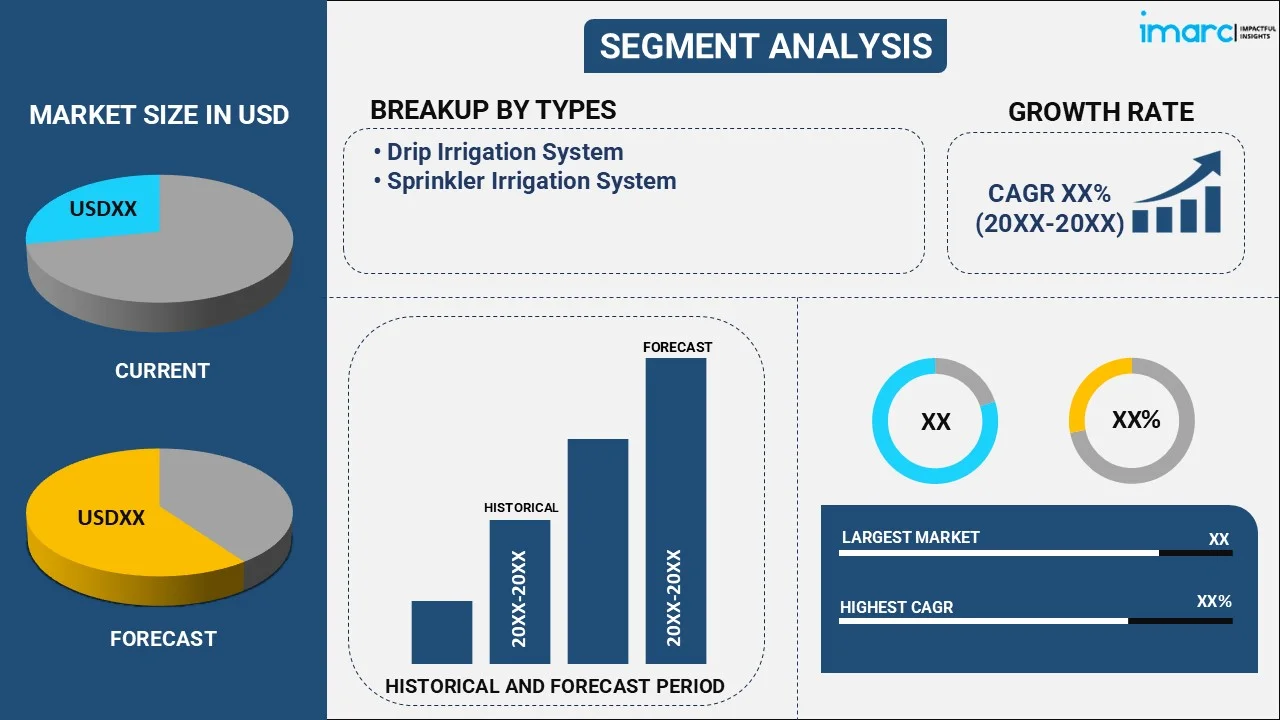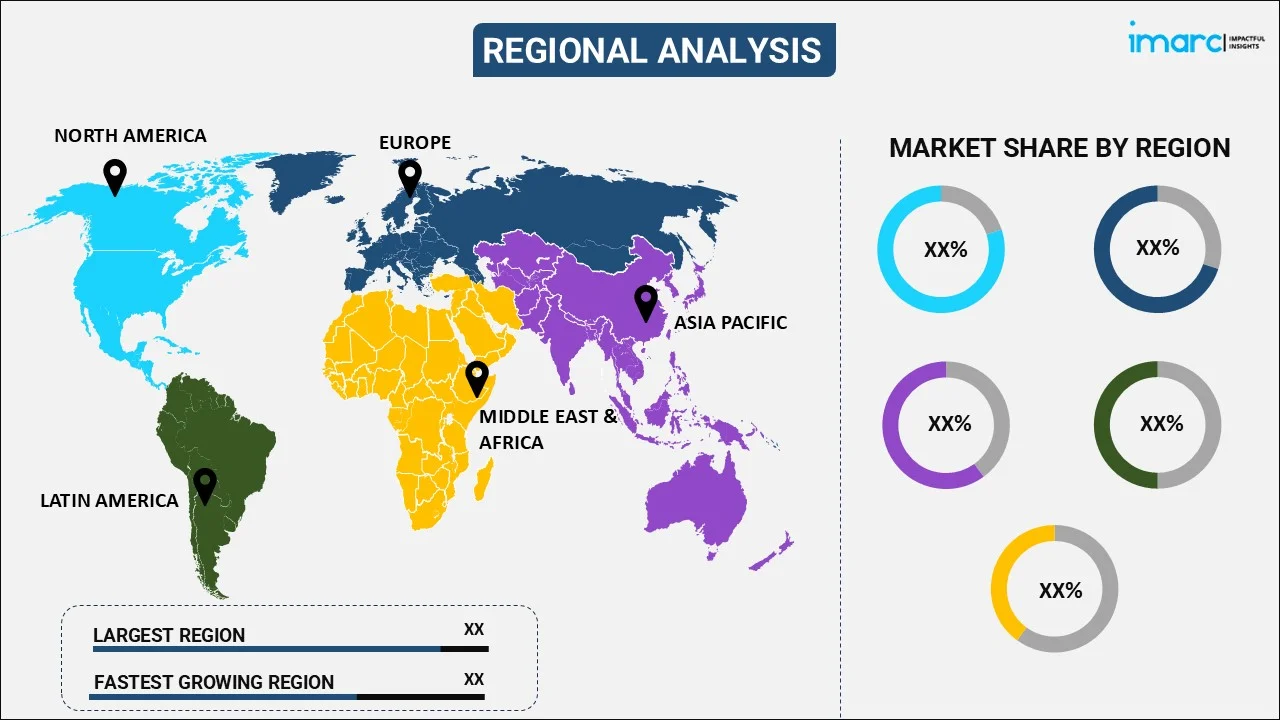
Micro Irrigation Systems Market Report by Type (Drip Irrigation System, Sprinkler Irrigation System), Crop Type (Field Crops, Orchard Crops, Landscape and Turf, and Others), End User (Agricultural, Industrial), and Region 2025-2033
Micro Irrigation Systems Market Size:
The global micro irrigation systems market size reached USD 12.6 Billion in 2024. Looking forward, IMARC Group expects the market to reach USD 24.7 Billion by 2033, exhibiting a growth rate (CAGR) of 7.38% during 2025-2033. Some of the key drivers supporting the market growth are the growing demand for food security, the rising focus on water conservation efforts on account of people's concerns about water shortage, and new developments like automation and precision agriculture.
|
Report Attribute
|
Key Statistics
|
|---|---|
|
Base Year
|
2024
|
|
Forecast Years
|
2025-2033
|
|
Historical Years
|
2019-2024
|
|
Market Size in 2024
|
USD 12.6 Billion |
|
Market Forecast in 2033
|
USD 24.7 Billion |
| Market Growth Rate (2025-2033) | 7.38% |
A micro irrigation system is a pipe distribution network that assists in applying small quantities of water frequently on the surface or subsurface of land. It relies on drippers, sprinklers, foggers and emitters placed along a water delivery line. It is an easy method of fertigation and chemigation, which is suitable for all types of soil. As it enhances crop yield and reduces labor and field preparation costs, it is gaining traction over conventional sprinkler systems. Moreover, it finds applications in horticulture, landscaping gardens and the practice of restoration ecology and environmental remediation across the globe.

Micro Irrigation Systems Market Trends:
Water Conservation Efforts
The growing focus on water conservation because of rising concerns about water scarcity is offering a favorable micro irrigation systems market outlook. Traditional irrigation methods often lead to inefficient water usage such as runoff and evaporation. Micro irrigation systems like drip and sprinkler systems deliver water directly to the plant's root zone that aid in minimizing water waste. This precision not only conserves water but also promotes healthier plant growth by providing the right amount of moisture where it’s needed. In areas facing severe droughts or water shortages, micro irrigation systems are becoming essential for sustaining agricultural productivity.
Growing Demand for Food Security
The escalating demand for food security owing to population growth is supporting the market growth. Traditional farming methods are not just sufficient to meet this demand, specifically in places with limited water resources. Micro irrigation systems are a perfect solution to this challenge as they can increase crop yields by delivering water and nutrients more effectively to plants. By optimizing water use and ensuring that crops receive consistent moisture, these systems enhance productivity and reduce the risk of crop failure due to under- or over-watering. Furthermore, the increasing need for precise water management for high-value crops such as fruits and vegetables are strengthening the micro irrigation system market growth. As food security becomes a critical concern for population, the demand for advanced irrigation technologies that can enhance agricultural output sustainably is expected to grow in the coming years. According to the United Nations (UN), the world population is projected to reach 8.6 billion in 2030.
Technological Advancements
The development of micro irrigation systems has been vital to the market's growth. Improvements in crop management and water distribution efficiency are made possible by new developments like automation, precision farming, and intelligent irrigation systems, which is thereby providing a favorable micro irrigation systems market outlook. In order to ensure efficient water consumption, smart irrigation systems can be integrated with sensors and weather forecasts to modify watering schedules based on current conditions. Other technologies including fertigation systems benefit in improving plant health by decreasing the need for separate applications. These solutions lower labor and operating expenses for farmers while simultaneously improving irrigation efficiency. Accessibility and ease of use are further improved by combining micro irrigation with digital tools like smartphone apps and remote monitoring systems.
Micro Irrigation Systems Market Segmentation:
IMARC Group provides an analysis of the key trends in each segment of the market, along with forecasts at the global, regional, and country levels for 2025-2033. Our report has categorized the market based on type, crop type, and end user.
Breakup by Type:

- Drip Irrigation System
- Sprinkler Irrigation System
Breakup by Crop Type:
- Field Crops
- Orchard Crops
- Landscape and Turf
- Others
Breakup by End User:
- Agricultural
- Industrial
Breakup by Region:

- North America
- United States
- Canada
- Asia-Pacific
- China
- Japan
- India
- South Korea
- Australia
- Indonesia
- Others
- Europe
- Germany
- France
- United Kingdom
- Italy
- Spain
- Russia
- Others
- Latin America
- Brazil
- Mexico
- Others
- Middle East and Africa
Competitive Landscape:
The report has also provided a comprehensive analysis of the competitive landscape in the global micro irrigation systems market. Detailed profiles of all major companies have also been provided. Some of the companies covered include:
- Antelco Pty Ltd
- Elgo Irrigation Ltd.
- Hunter Industries
- Irritec S.p.A
- Jain Irrigation Systems Ltd.
- Lindsay Corporation
- Mahindra EPC Irrigation Limited (Mahindra & Mahindra Limited)
- Nelson Irrigation Corporation
- Netafim (Orbia)
- Rain Bird Corporation
- Rivulis Irrigation Ltd.
- The Toro Company
Kindly note that this only represents a partial list of companies, and the complete list has been provided in the report.
Micro Irrigation Systems Market News:
- 29 October 2023: Netafim India, a leading smart-irrigation solution provider, launched its groundbreaking product, Toofan, an innovative irrigation technology that promises to transform farming for growers of all scales. Netafim India aims to provide an affordable yet high-performance micro irrigation system that not only ensures consistent and uniform yields but also aids in reducing the operational costs of farmers.
Report Coverage:
| Report Features | Details |
|---|---|
| Base Year of the Analysis | 2024 |
| Historical Period | 2019-2024 |
| Forecast Period | 2025-2033 |
| Units | Billion USD |
| Segment Coverage | Type, Crop Type, End User, Region |
| Region Covered | Asia Pacific, Europe, North America, Latin America, Middle East and Africa |
| Countries Covered | United States, Canada, Germany, France, United Kingdom, Italy, Spain, Russia, China, Japan, India, South Korea, Australia, Indonesia, Brazil, Mexico |
| Companies Covered | Antelco Pty Ltd, Elgo Irrigation Ltd., Hunter Industries, Irritec S.p.A, Jain Irrigation Systems Ltd., Lindsay Corporation, Mahindra EPC Irrigation Limited (Mahindra & Mahindra Limited), Nelson Irrigation Corporation, Netafim (Orbia), Rain Bird Corporation, Rivulis Irrigation Ltd. and The Toro Company |
| Customization Scope | 10% Free Customization |
| Post-Sale Analyst Support | 10-12 Weeks |
| Delivery Format | PDF and Excel through Email (We can also provide the editable version of the report in PPT/Word format on special request) |
Key Questions Answered in This Report
The global micro irrigation systems market was valued at USD 12.6 Billion in 2024.
We expect the global micro irrigation systems market to exhibit a CAGR of 7.38% during 2025-2033.
The rising demand for micro irrigation systems to utilize arable land efficiently and ensure high crop yield is primarily driving the global micro irrigation systems market.
The sudden outbreak of the COVID-19 pandemic had led to the implementation of stringent lockdown regulations across several nations, resulting in a decline in various agricultural practices, thereby negatively impacting the global market for micro irrigation systems.
Based on the type, the global micro irrigation systems market can be segmented into drip irrigation system and sprinkler irrigation system. Currently, drip irrigation system holds the majority of the total market share.
Based on the crop type, the global micro irrigation systems market has been divided into field crops, orchard crops, landscape and turf, and others. Among these, orchard crops currently exhibit a clear dominance in the market.
Based on the end user, the global micro irrigation systems market can be categorized into agricultural and industrial. Currently, the agricultural sector accounts for the largest market share.
On a regional level, the market has been classified into North America, Asia-Pacific, Europe, Latin America, and Middle East and Africa, where Asia-Pacific currently dominates the global market.
Some of the major players in the global micro irrigation systems market include Antelco Pty Ltd, Elgo Irrigation Ltd., Hunter Industries, Irritec S.p.A, Jain Irrigation Systems Ltd., Lindsay Corporation, Mahindra EPC Irrigation Limited (Mahindra & Mahindra Limited), Nelson Irrigation Corporation, Netafim (Orbia), Rain Bird Corporation, Rivulis Irrigation Ltd., and The Toro Company.
Need more help?
- Speak to our experienced analysts for insights on the current market scenarios.
- Include additional segments and countries to customize the report as per your requirement.
- Gain an unparalleled competitive advantage in your domain by understanding how to utilize the report and positively impacting your operations and revenue.
- For further assistance, please connect with our analysts.
 Inquire Before Buying
Inquire Before Buying
 Speak to an Analyst
Speak to an Analyst
 Request Brochure
Request Brochure
 Request Customization
Request Customization




.webp)




.webp)












